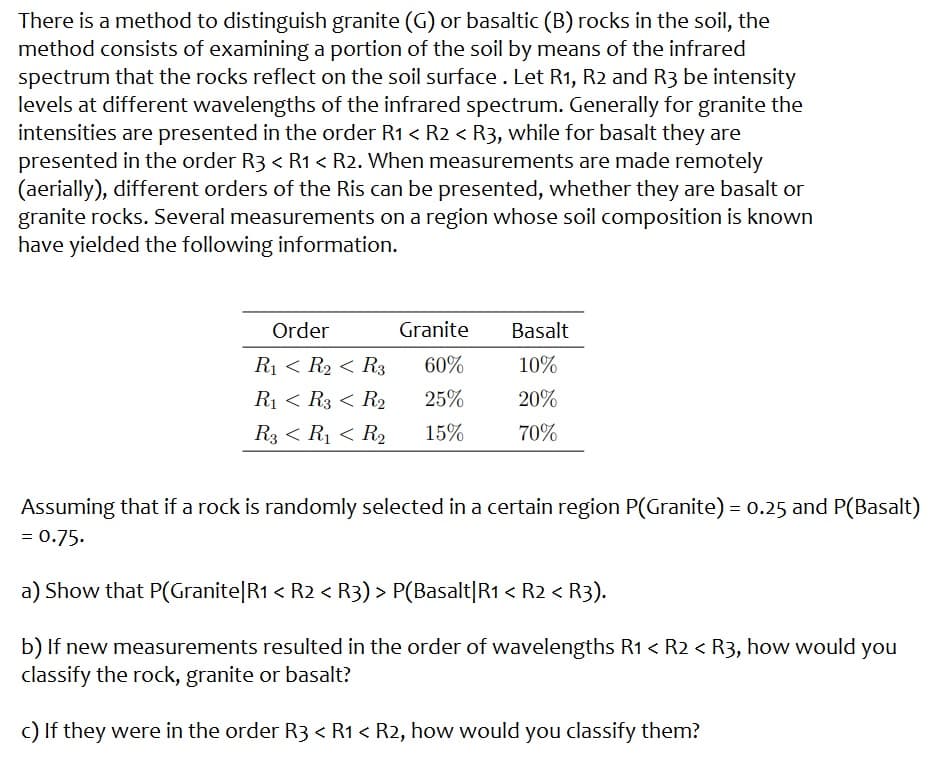There is a method to distinguish granite (G) or basaltic (B) rocks in the soil, the method consists of examining a portion of the soil by means of the infrared spectrum that the rocks reflect on the soil surface. Let R1, R2 and R3 be intensity levels at different wavelengths of the infrared spectrum. Generally for granite the intensities are presented in the order R1 < R2 < R3, while for basalt they are presented in the order R3 < R1 < R2. When measurements are made remotely (aerially), different orders of the Ris can be presented, whether they are basalt or granite rocks. Several measurements on a region whose soil composition is known have yielded the following information.
There is a method to distinguish granite (G) or basaltic (B) rocks in the soil, the method consists of examining a portion of the soil by means of the infrared spectrum that the rocks reflect on the soil surface. Let R1, R2 and R3 be intensity levels at different wavelengths of the infrared spectrum. Generally for granite the intensities are presented in the order R1 < R2 < R3, while for basalt they are presented in the order R3 < R1 < R2. When measurements are made remotely (aerially), different orders of the Ris can be presented, whether they are basalt or granite rocks. Several measurements on a region whose soil composition is known have yielded the following information.
Algebra & Trigonometry with Analytic Geometry
13th Edition
ISBN:9781133382119
Author:Swokowski
Publisher:Swokowski
Chapter7: Analytic Trigonometry
Section7.6: The Inverse Trigonometric Functions
Problem 91E
Related questions
Question

Transcribed Image Text:There is a method to distinguish granite (G) or basaltic (B) rocks in the soil, the
method consists of examining a portion of the soil by means of the infrared
spectrum that the rocks reflect on the soil surface. Let R1, R2 and R3 be intensity
levels at different wavelengths of the infrared spectrum. Generally for granite the
intensities are presented in the order R1 < R2 < R3, while for basalt they are
presented in the order R3 < R₁1 < R2. When measurements are made remotely
(aerially), different orders of the Ris can be presented, whether they are basalt or
granite rocks. Several measurements on a region whose soil composition is known
have yielded the following information.
Order
Granite
R₁ R₂ R3 60%
R₁ < R3 < R₂
25%
R3 < R₁ < R₂
15%
Basalt
10%
20%
70%
Assuming that if a rock is randomly selected in a certain region P(Granite) = 0.25 and P(Basalt)
= 0.75.
a) Show that P(Granite|R1 < R2 < R3) > P(Basalt|R1 < R2 < R3).
b) If new measurements resulted in the order of wavelengths R1 < R2 < R3, how would you
classify the rock, granite or basalt?
c) If they were in the order R3 < R₁1 < R2, how would you classify them?
Expert Solution
This question has been solved!
Explore an expertly crafted, step-by-step solution for a thorough understanding of key concepts.
Step by step
Solved in 4 steps

Recommended textbooks for you

Algebra & Trigonometry with Analytic Geometry
Algebra
ISBN:
9781133382119
Author:
Swokowski
Publisher:
Cengage

Mathematics For Machine Technology
Advanced Math
ISBN:
9781337798310
Author:
Peterson, John.
Publisher:
Cengage Learning,

Trigonometry (MindTap Course List)
Trigonometry
ISBN:
9781337278461
Author:
Ron Larson
Publisher:
Cengage Learning

Algebra & Trigonometry with Analytic Geometry
Algebra
ISBN:
9781133382119
Author:
Swokowski
Publisher:
Cengage

Mathematics For Machine Technology
Advanced Math
ISBN:
9781337798310
Author:
Peterson, John.
Publisher:
Cengage Learning,

Trigonometry (MindTap Course List)
Trigonometry
ISBN:
9781337278461
Author:
Ron Larson
Publisher:
Cengage Learning